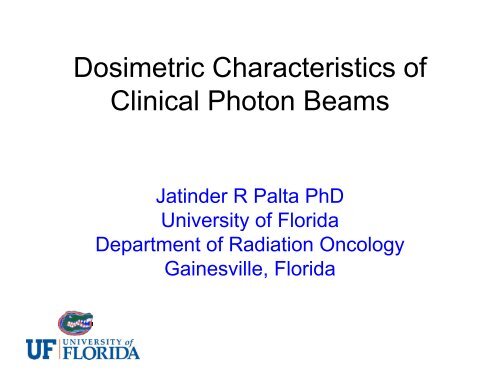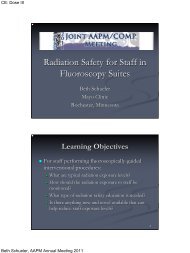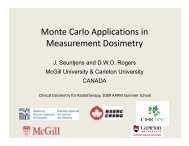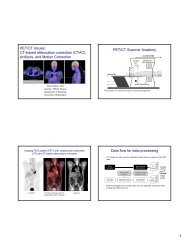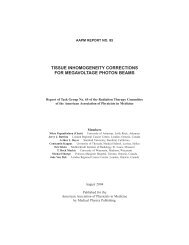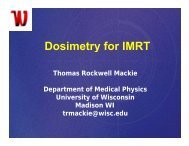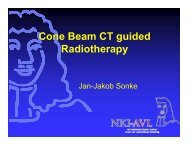Dosimetric Characteristics of Clinical Photon Beams
Dosimetric Characteristics of Clinical Photon Beams
Dosimetric Characteristics of Clinical Photon Beams
You also want an ePaper? Increase the reach of your titles
YUMPU automatically turns print PDFs into web optimized ePapers that Google loves.
<strong>Dosimetric</strong> <strong>Characteristics</strong> <strong>of</strong><br />
<strong>Clinical</strong> <strong>Photon</strong> <strong>Beams</strong><br />
Jatinder R Palta PhD<br />
University <strong>of</strong> Florida<br />
Department <strong>of</strong> Radiation Oncology<br />
Gainesville Gainesville, Florida
Disclosures<br />
�Research �Research development grants from Philips<br />
Medical Systems, Elekta Oncology<br />
Systems Systems, and Sun Nuclear Associates Associates.<br />
�NIH research award.<br />
�B �Bankhead kh d CColey l research h award.<br />
d
Learning g Objectives j<br />
�Understanding dosimetric properties <strong>of</strong><br />
clinical photon beams.<br />
�Understanding gpphysical y pparameters<br />
that<br />
affect dosimetric properties <strong>of</strong> clinical<br />
photon p beams.<br />
�Understand the need for accurate<br />
characterization <strong>of</strong> clinical photon beams<br />
in a treatment planning system.
<strong>Photon</strong> Beam Delivery Systems<br />
S band Linear Accelerators<br />
X band Linear Accelerators<br />
Medical Linear<br />
Accelerators:<br />
�� Accelerate electrons in ppulses lses<br />
to kinetic energies from 4 to 25<br />
MeV.<br />
�Use �Use non-conservative<br />
microwave RF fields in the<br />
frequency range from 103 MHz (L<br />
band) to 104 band) to 10 MHz (X band), with<br />
the vast majority running at 2856<br />
MHz (S band).<br />
� Some provide beams only in<br />
the low megavoltage range (4-6<br />
MV), while others provide both<br />
photons and electrons at various<br />
megavoltage l energies. i A typical i l<br />
modern high-energy linac can<br />
provide 2-3 photon energies.
Sources <strong>of</strong> radiation that determine dosimetric<br />
characteristics <strong>of</strong> clinical photon beams<br />
Indirect (headscatter)<br />
Flattening filter<br />
Monitor Chamber<br />
Collimator jaws<br />
Electron<br />
Contamination<br />
MLC<br />
Charged particle<br />
contamination dose<br />
Secondary<br />
electrons<br />
Source<br />
Direct<br />
Output radiation or<br />
Incident radiation<br />
Primary dose<br />
SScatter tt ddose<br />
�Direct Radiation (Focal<br />
Radiation)<br />
�<strong>Photon</strong> radiation generated<br />
at the target g that reaches<br />
patient without any<br />
intermediate interactions.<br />
�Indirect Radiation (Extra-<br />
focal Radiation):<br />
�<strong>Photon</strong> radiation with a<br />
history <strong>of</strong> interaction/scattering<br />
in the head <strong>of</strong> the treatment<br />
unit with the flattening filter filter,<br />
collimators, or other structures<br />
in the treatment head .<br />
�Contaminant<br />
electrons/positrons<br />
� secondary electrons and<br />
positrons released from<br />
interactions with either the<br />
treatment head or the air<br />
column .<br />
AAPM TG74 Report
Sources <strong>of</strong> Direct and Indirect<br />
Radiation<br />
� A Monte Carlo study (Chaney et al., Med. Phys. 21,1994)<br />
� Siemens MD2, 6MV<br />
Direct<br />
Indirect
Characterizing <strong>Dosimetric</strong> Properties<br />
<strong>of</strong> <strong>Clinical</strong> <strong>Photon</strong> <strong>Beams</strong><br />
� Beam penetration<br />
�� Normalized depth dose (NDD) or tissue phantom ratio<br />
(TPR).<br />
� Beam Output<br />
� Total output ratio: S c,p, in-air output ratio: S c, phantom<br />
scatter factor: S p.<br />
�� Cross Cross-beam beam pr<strong>of</strong>ile<br />
� Isodose distribution.<br />
�� Attenuation factors for beam modifiers<br />
� hard wedges, compensators, trays, etc.<br />
With the ultimate goal <strong>of</strong> ensuring that computerized treatment<br />
With the ultimate goal <strong>of</strong> ensuring that computerized treatment<br />
plans accurately reflect the dose received by patients
Beam Penetration<br />
D<br />
�� � d<br />
d f Q�<br />
d<br />
d,<br />
s,<br />
f , Q �<br />
NDD<br />
f<br />
D<br />
dref<br />
where d is the depth <strong>of</strong> measurement on the<br />
central axis <strong>of</strong> the phantom, s is the field size at<br />
the surface <strong>of</strong> the phantom, f is the sourcesurface-distance,<br />
Q is the quality q y <strong>of</strong> the clinical<br />
photon beam, and Dd and Ddref are dose at<br />
depth d and dref respectively.<br />
TPR data can be determined from measured<br />
NDD as follows:<br />
Water<br />
s<br />
d<br />
�� �<br />
2<br />
f � d � ��<br />
S �� s ��<br />
�� �<br />
TPR�d, s � � �<br />
d , Q � NDD d,<br />
s,<br />
f , Q � � �<br />
f dref<br />
�<br />
� � �<br />
p<br />
S<br />
p<br />
dref<br />
�s� d
Normalized Depth Dose Data<br />
Energy Dependence<br />
SSurface f region i<br />
BBuildup ild region i<br />
15 MV<br />
6MV 6 MV<br />
FS = 10 x 10 cm 2<br />
TCPE region
Normalized Depth Dose Data<br />
Field Size Dependence<br />
This depth corresponds to range 15 MV <strong>Photon</strong> Beam<br />
<strong>of</strong> the highest energy<br />
contaminant charged particles<br />
4x4<br />
16x16
Normalized Depth Dose Data<br />
Wedge/Open Comparison<br />
6 MV (W/O)<br />
15 MV (W/O)<br />
FS=10x10cm2<br />
FS = 10 x 10 cm2
Normalized Depth Dose Data<br />
Wedge/Open Comparison<br />
Minima
Normalized Depth Dose Data<br />
Field sizes:<br />
6x6, 10x10<br />
and 20x20<br />
cm2 cm2 6 MV<br />
- Siemens<br />
-- Varian<br />
.Elekta . Elekta<br />
18 MV<br />
These data from<br />
Radiological<br />
Physics Center<br />
show that all NDD<br />
for both 6 and 18<br />
MV photon beams<br />
at depths <strong>of</strong> 5 cm<br />
and 15 cm for<br />
different field sizes<br />
have a<br />
maximum i % %σ <strong>of</strong> f<br />
0.5% and this<br />
increases to 0.7%<br />
at a depth <strong>of</strong> 20 cm cm.
Monte Carlo Calculated <strong>Photon</strong><br />
Beam Spectra<br />
•The spectral shapes<br />
are somewhat similar<br />
•The differences at the<br />
high-energy end are<br />
caused by the<br />
differences in the<br />
mean incident electron<br />
energies and their<br />
spread<br />
Sheikh-Bagheri & Rogers, Med. Phys.,<br />
29, 2002
Monte Carlo Calculated Average Energies<br />
•The average energies<br />
for the same nominal<br />
accelerating potential<br />
are somewhat similar<br />
•The average energies<br />
decrease at <strong>of</strong>f-axis<br />
distances for all clinical<br />
beams<br />
• more pronounced difference<br />
at higher g energies g<br />
Sheikh-Bagheri & Rogers, Med. Phys.,<br />
29, 2002
Beam Penetration for Irregularly-<br />
Shaped Fields<br />
Concept p <strong>of</strong> Equivalent q Square: q<br />
�The equivalent field is defined as<br />
that standard (square or circular)<br />
field which has the same centralaxis<br />
depth dose characteristics as<br />
the given non-standard field.<br />
“Day’s Rule”:<br />
S<br />
�� �� �� r<br />
r �<br />
S 1<br />
��r<br />
�<br />
��r<br />
�<br />
r � S 1�<br />
e<br />
�<br />
� � � � � r � e<br />
�<br />
�<br />
Water<br />
S(r) = the central axis scatter in a field <strong>of</strong> radius r, S∞ = the central axis scatter in<br />
fi field ld <strong>of</strong> f infinite i fi it radius, di λ iis a scaling li parameter, t and d μ iis a di dimensionless i l shape h<br />
parameter. They computed equivalent square fields for a complete set <strong>of</strong><br />
rectangular fields using a value <strong>of</strong> λ=0.26 cm-1 and μ=0.5.<br />
s<br />
f<br />
d
Equivalent square d<br />
Sterling g Formula:<br />
(Sterling et.al., Brit. J. Radiol. 37, 544 (1964))<br />
2LW<br />
S ��<br />
��<br />
4 A / P<br />
L �W<br />
Assuming, λ = 0.26 cm cm-1., 1., and μ = 0.5<br />
L/2 W/2<br />
SLW ( , ) 4 Dxydxdy ( , )<br />
� � �<br />
L / W<br />
0 0<br />
1 2 3 4 5<br />
SLW ( , ) / S (10,10) 1.000 0.993 0.982 0.969 0.958<br />
L<br />
W s
KLEIN- NISHINA CROSS SECTION<br />
FOR THE COMPTON INTERACTION<br />
d e�<br />
d�<br />
Ψ<br />
�<br />
2 2<br />
0 2<br />
sin<br />
r ��<br />
h�<br />
' ��<br />
��<br />
h�<br />
h�<br />
'<br />
� � � � �<br />
2 � h�<br />
� � h�<br />
' h�<br />
PHOTONS SCATTERED AT AN ANGLE, Ψ<br />
��<br />
� �<br />
�<br />
PHOTONS SCATTERED INTO A UNIT<br />
SOLID ANGLE, Ω<br />
SOLID ANGLE AVAILABLE PER<br />
UNIT ANGLE<br />
d�<br />
d d��<br />
� 2� sin �<br />
Based on the kinematics <strong>of</strong> Compton interaction, the average<br />
p g<br />
energy <strong>of</strong> scattered photons is less than 1Mev and is independent<br />
<strong>of</strong> the incident energy.
Measurement <strong>of</strong> Normalized Depth<br />
DDose ddata<br />
Follow AAPM TG Report p # 106 recommendations:<br />
� Use 4-5 mm diameter ion chamber for depth<br />
beyond 1cm.<br />
� Use parallel plate or extrapolation chamber to<br />
measure data near the surface.<br />
�� Di Diodes d and d di diamond d ddetectors t t are appropriate i t<br />
as long as data measured with these detectors<br />
is scoss cross-referenced e e e ced to data measured easu ed with t aan<br />
ion chamber.<br />
� Prone to radiation damage and non-linear response.
Is depth ionization data depth dose?<br />
YES!!!<br />
With the caveat,<br />
�� TCPE exists at the point <strong>of</strong> measurement<br />
measurement.<br />
� the energy spectrum <strong>of</strong> incident photons does not change with the<br />
depth.<br />
�� fluence across the detector remains the same same.<br />
These conditions are met at depths beyond the range <strong>of</strong><br />
contaminant charged particles<br />
However at shallow depth, The contaminants and<br />
secondary electrons have energy spectra that change<br />
rapidly with depth.<br />
� Results in a variation <strong>of</strong> ~10% in restricted mass stopping power<br />
ratio data for water and air.<br />
�Translates into a spatial uncertainty <strong>of</strong> less than 1.5 mm in dose in the<br />
build up region
S c<br />
c<br />
S<br />
p<br />
�� s<br />
�<br />
Beam Output<br />
S<br />
c,<br />
p<br />
S<br />
c<br />
�� s��<br />
�� c<br />
f<br />
f<br />
(Derived)<br />
S c,p<br />
10 cm<br />
Water<br />
c
In-air output Ratio<br />
Elekta: 4-18 MV clinical photon beams beams.
Monte Carlo Calculations <strong>of</strong> In-<br />
Simulation Geometry<br />
(Varian 2100EX)<br />
Ai Air Output O t t Ratio R ti<br />
(BEAMnrc code)<br />
O o<br />
/tex/r<strong>of</strong>/clxyro<br />
1.05<br />
1.00<br />
0.95<br />
0.90<br />
In-Air Output Ratio<br />
6 MV measured<br />
6 MV calc calculated lated<br />
18 MV measured<br />
18 MV calculated<br />
0 5 10 15 20 25 30 35 40 45<br />
Side <strong>of</strong> square field /cm
Energy spectrum <strong>of</strong> head scattered photons<br />
Mean Energy:0.5 MeV<br />
(Varian 2100C.)
Energy spectrum <strong>of</strong> head scattered photons<br />
Mean Energy:0 Energy:0.5 5 MeV<br />
(Varian 2100C.)
In-air output Ratio<br />
e: Elekta, , s: Siemens, , and v: Varian<br />
(for clinical photon beams ranging from 6-25 MV.
Flattening Filter<br />
Beam Modifier<br />
(internal wedge)<br />
Lower Collimator<br />
Beam Modifier<br />
(external wedge)<br />
Monitor Back Scatter<br />
Monitor Chamber<br />
Upper Collimator<br />
Tertiary Collimator<br />
(Cerrobend Block<br />
or Varian MLC)<br />
Machine MBS Publication<br />
Varian Clinac 1800 1-5% Kubo, Med. Phys.<br />
16, 295 (1987)<br />
Therac 20 7.5% Hounsell, , P.M.B.<br />
43, 445 (1998)<br />
Elekta SL15
MMeasurement t <strong>of</strong> f In-Air I Ai Output O t t Ratios R ti<br />
• Mini phantom p<br />
– Water-equivalent materials.<br />
– 4g/cm2 diameter and 10g/cm2 depth to maintain lateral<br />
CPE and eliminate contaminant electron electron.<br />
• For small segment fields (c
Cross Beam <strong>Characteristics</strong><br />
� Affected by the radially symmetric conical high Zmaterial<br />
flattening g filter, , which<br />
� Flattens the beam by differentially absorbing more photons in the<br />
center and less in the periphery<br />
� unwanted consequence <strong>of</strong> flattening the beam is the differential<br />
change in beam quality at <strong>of</strong>f-axis points points.<br />
� hardens the beam<br />
� Cross beam flatness is defined as:<br />
D<br />
F � 100�<br />
D<br />
max<br />
max<br />
� D<br />
� One flattening filter for each clinical photon beam results in a<br />
compromise <strong>of</strong> beam flatness characteristics <strong>of</strong> small and large<br />
fields.<br />
�� Fl Flattening tt i filt filters are ddesigned i d tto give i a gradually d ll iincreasing i radial di l iintensity. t it<br />
This is referred to as “horns” on a cross-beam pr<strong>of</strong>ile<br />
� Cross beam pr<strong>of</strong>iles may not be radially symmetric due<br />
to non circular focal spot. p<br />
� Therefore, cross-beam data is characterized by a set <strong>of</strong> two<br />
orthogonal dose pr<strong>of</strong>iles measured perpendicular to the beam’s<br />
central axis at a given depth in a phantom<br />
�<br />
D<br />
min<br />
min
Cross Beam Pr<strong>of</strong>ile<br />
6 MV <strong>Photon</strong> Beam, Depth <strong>of</strong> 5.0 cm, Field size <strong>of</strong> 4x4, 10.4x10.4, and 21x21 cm 2 .<br />
The flatness <strong>of</strong> photon beams is extremely sensitive to change in energy <strong>of</strong> the<br />
incident beam. A small change in the penetrative quality <strong>of</strong> a photon beam results in<br />
very large change in beam flatness.
Cross Beam Pr<strong>of</strong>ile<br />
6 MV <strong>Photon</strong> Beam, , Field Size <strong>of</strong> 10.4x10.4 cm2, , Depths p <strong>of</strong> 1.5, , 5.0, , 10.0, , 15.0, ,<br />
and 25.0 cm.<br />
The field flatness changes with depth. This is attributed to an increase in scatter to<br />
primary dose ratio with increasing depth and decreasing incident photon energy <strong>of</strong>f<br />
axis
Effect <strong>of</strong> Electron Steering<br />
on Beam Flatness<br />
Symmetric Tilted Displaced
Effect <strong>of</strong> a Dipole p Magnet g on Exit<br />
Energy Spread<br />
Beam<br />
Radial Displacement<br />
Radial Divergence
Cross Beam Symmetry<br />
S<br />
� 100 �<br />
Area<br />
left<br />
�<br />
Area �<br />
left<br />
Dosimetry and beam<br />
steering system<br />
Area<br />
Area<br />
right<br />
right
Isodose Distribution<br />
30 cm X 30 cm<br />
18 MV X-ray beam
6 MV<br />
Isodose Distributions<br />
(20 X 20 Cm2 (20 X 20 Cm ) 2 )<br />
18 MV<br />
Note contaminant electrons contribute to dose outside the field<br />
at shallow s a o depths. dept s The e magnitude ag tude aand d eextent te t o<strong>of</strong> dose outs outside de<br />
the geometric edge <strong>of</strong> a field at shallow depths increases with<br />
beam energy.
Isodose Distributions<br />
(20 X 20 Cm2 (20 X 20 Cm 18 MV)<br />
2 , 18 MV)<br />
Note Contaminant electrons contribute to dose outside the<br />
field at shallow depths. p The magnitude g and extent <strong>of</strong> dose<br />
outside the geometric edge <strong>of</strong> a field at shallow depths<br />
increases even more in the presence <strong>of</strong> beam modifiers.
Cross Beam Measurements<br />
Diameter<br />
Penumbra<br />
20%~80%<br />
Wh What t iis th the affect ff t <strong>of</strong> f<br />
detector size?<br />
�Incorrect<br />
measurement <strong>of</strong><br />
penumbra region<br />
Diode CC04 CC13<br />
0.8x0.8<br />
mm 2 4 mm 6 mm<br />
4.0 mm 6.1 mm 7.2 mm
Detector Size Effect on TPS<br />
Commissioning<br />
Impact <strong>of</strong><br />
Treatment Planning detector size<br />
System<br />
effect on dose<br />
Commissioning di distribution???<br />
t ib ti ???<br />
Yan G et. al., Med. Phys (35)., 2008
Extraction <strong>of</strong> True Pr<strong>of</strong>ile
IMRT QA results: DTA 2%/2 mm<br />
CC13<br />
CC04<br />
Deconvolved
Measurement <strong>of</strong> Attenuation<br />
FFactors t for f Beam B Modifiers M difi<br />
� The attenuation factor for a beam modifier is defined as<br />
the ratio <strong>of</strong> the dose rate at the point <strong>of</strong> calculation for a<br />
given field with and without the modifier in place.<br />
� Attenuation factors for devices such as block trays, y , accessories<br />
etc. are <strong>of</strong>ten assumed to be independent <strong>of</strong> field size, depth and<br />
SSD.<br />
� These factors should be measured at a depth well beyond the<br />
maximum range <strong>of</strong> electron contamination<br />
� The attenuation devices that are in contact with the<br />
patient skin (immobilization apparatus, table top, etc.)<br />
req require ire additional considerations<br />
considerations.<br />
� These devices not only attenuate the incident beam but they<br />
introduce scatter radiation that increase the scatter to primary<br />
ratio within the patient patient.<br />
� It is best to include such attenuation devices as a part <strong>of</strong> the patient<br />
in 3DRTPS
Measurement <strong>of</strong> Wedge Factors<br />
� The WF is defined as the ratio <strong>of</strong> the dose rate<br />
at t the th reference f depth d th for f a wedged d d field fi ld tto th that t<br />
for the same field without a wedge modifier .<br />
�� The field size dependency <strong>of</strong> the WF originates from<br />
a wedge-induced increase in head scatter.<br />
� the field size dependence p <strong>of</strong> the WF is correctly y<br />
accounted for by in-air output ratios (Sc) wedge<br />
specifically measured for wedged fields<br />
�These �These data should be measured with the chamber axis<br />
perpendicular to the gradient direction <strong>of</strong> the wedge<br />
�Two sets <strong>of</strong> measurements should be made with the wedge<br />
in opposite orientations to ensure the correct placement <strong>of</strong><br />
the chamber
Characterizing <strong>Clinical</strong> <strong>Photon</strong><br />
Ahnesjo et al al., PMB 1999<br />
B<strong>Beams</strong> iin 3DRTPS
Approaches to Dose Computation Algorithms<br />
Reconstitute water data<br />
Calculate inhomogeneity<br />
corrections to water data<br />
Data measured in water<br />
and in air<br />
Parameterize water data<br />
Calculate dose directly<br />
based on beam and<br />
phantom configurations<br />
“Correction<br />
Correction” ” based “Model Model” ” based<br />
methods methods<br />
Figure 8.9,The Modern Technology <strong>of</strong><br />
Radiation Oncology; J. Van Dyk
Correction vs. Model Based Methods<br />
Correction Based Model Based<br />
Measured data used as basis for<br />
Dose Computation.<br />
Measured data used to setup<br />
description <strong>of</strong> treatment beam.<br />
Require measurements with buildup Require a parameter to estimate size<br />
cap in air or in a mini-phantom. <strong>of</strong> photon source at target.<br />
Require lots <strong>of</strong> data. Generating<br />
functions used to reduce size <strong>of</strong><br />
data set for convenient clinical use<br />
(i.e. less storage space).<br />
Require more time for tuning <strong>of</strong><br />
model parameters.<br />
p<br />
Patient dose distribution obtained by Patient dose distribution obtained by<br />
first computing Dose in water from<br />
generating function, then correcting<br />
for tissue heterogeneity, patient<br />
contour, t and d bbeam modifiers.<br />
difi<br />
computing beam and beam transport<br />
(i.e. beam interactions in treatment<br />
head and in patient) directly.
Accuracy Goal in Dose Calculations<br />
•Required q accuracy y (overall ( treatment < 5%): )<br />
Ahnesjo et al., PMB 1999
Characterizing <strong>Clinical</strong> <strong>Photon</strong><br />
<strong>Beams</strong> in 3DRTPS<br />
�� MUST model the following features realistically:<br />
� Finite size <strong>of</strong> source (& penumbra)<br />
�� EExtra-focal t f l radiation di ti (primary ( i collimator, lli t fl flattening tt i filt filter) )<br />
� Beam spectrum (& change in spectrum with position)<br />
� Beam intensity variation across field (e.g., beam horns)<br />
� Transmission through secondary collimators<br />
�� SScatter tt outside t id fi field ld ( (related l t d tto extra-focal t f l radiation) di ti )<br />
� MLC, blocks, block tray<br />
�� Dynamic wedge wedge, fixed wedge wedge, compensators (beam<br />
hardening)
Characterizing <strong>Clinical</strong> <strong>Photon</strong><br />
Caveats:<br />
<strong>Beams</strong> in 3DRTPS<br />
� Almost all photon dose computation with convolution models<br />
assumes kernel invariance, which requires the photon dose kernel to<br />
be constant with spatial locations in the calculation phantom phantom.<br />
� However, in clinical treatments, patient inhomogeneities, as well as beam<br />
divergence and polychromaticity, cause kernel variation in various ways.<br />
� Modeling <strong>of</strong> charged particle contaminants is at best an<br />
approximation <strong>of</strong> real clinical situation<br />
�� Modeling <strong>of</strong> indirect radiation as a single or multiple analytical<br />
source functions, modeling <strong>of</strong> <strong>of</strong>f-axis s<strong>of</strong>tening with a simple<br />
parametric fit, source size, etc. are best effort estimates <strong>of</strong> physical<br />
processes
Characterizing <strong>Clinical</strong> <strong>Photon</strong><br />
Caveats (continued):<br />
<strong>Beams</strong> in 3DRTPS<br />
� One can always use a set <strong>of</strong> beam modeling parameters<br />
to get the best agreement between the computed and<br />
measured beam data in a phantom phantom. .<br />
�However, that would not be a sufficient condition for robust and<br />
accurate beam modeling .<br />
� The value or function used to describe a parameter<br />
should have some physical meaning.<br />
�each parameter used in the dose calculation algorithm should<br />
model the physical reality it represents even if there is less than<br />
perfect agreement between measure and computed data.<br />
� The observed differences <strong>of</strong>ten reflect limitations <strong>of</strong> the dose<br />
computation algorithm
Benchmark Dataset<br />
(D (Developed l d under d NIH iinitiative) iti ti )<br />
A collaborative effort involving Sun Nuclear Associates; the<br />
contractor, t t and d consultants lt t from: f the th University U i it <strong>of</strong> f Florida; Fl id<br />
the RPC at M.D. Anderson Cancer Center; the University<br />
<strong>of</strong> Iowa; and the Vassar Brothers Hospital. p<br />
� Already measured a complete set <strong>of</strong> data on the new<br />
generation <strong>of</strong> Elekta (Synergy), Siemens (Oncor) and<br />
Varian (Trilogy) linear accelerators<br />
�Measured data are comprehensive in beam geometries to<br />
validate dose computation for any clinical situation.<br />
�data are sufficient in spatial resolution and were validated by<br />
independent measurements<br />
� This benchmark datasets will be sufficient for the TPS<br />
� This benchmark datasets will be sufficient for the TPS<br />
companies to compare the accuracy <strong>of</strong> their dose<br />
modeling for treatment delivery
Summary<br />
� The dosimetric properties <strong>of</strong> a clinical photon<br />
beam are characterized by:<br />
� Its ability to penetrate a tissue-like medium (water)<br />
� its change g in dose output p with field size<br />
� Its cross beam behavior<br />
� Its attenuation through modifying devices (e.g., wedge,<br />
compensator etc.) etc )<br />
� The dosimetric properties <strong>of</strong> clinical photon<br />
beams from linacs depend on the photon energy<br />
fluence distribution emanating from the treatment<br />
head, on the geometry <strong>of</strong> the linac, and on the<br />
radiological properties <strong>of</strong> the medium with which it<br />
interacts.
Summary<br />
�It is quite evident that all modern clinical<br />
li linear accelerators l t (li (linacs) ) <strong>of</strong> f a particular ti l<br />
commercial make produce beams <strong>of</strong> very<br />
similar characteristics<br />
�High quality benchmark data have already been<br />
acquired by comprehensively characterizing<br />
single linacs <strong>of</strong> each make.<br />
�These benchmark data thoroughly describe the<br />
characteristics <strong>of</strong> photon beams so that<br />
treatment-planning companies and clinics<br />
throughout the United States can use it to<br />
examine the accuracy <strong>of</strong> dose-calculation<br />
algorithms.


